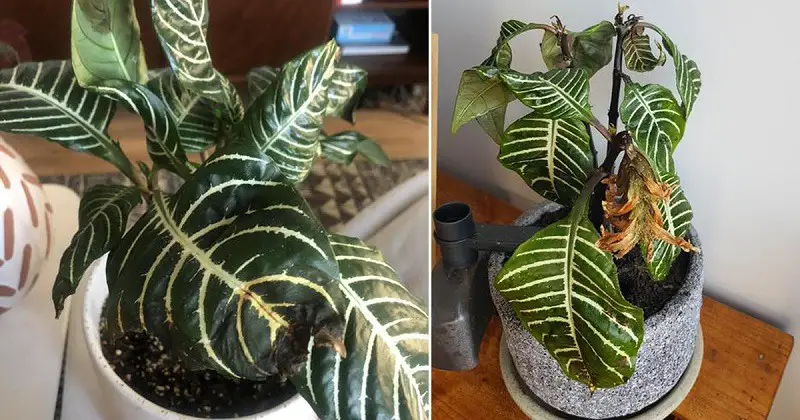The zebra plant can thrive both indoors and outdoors. The zebra-like patterns are the reasons behind the popularity of this houseplant. The leaves turning brown are due to an inappropriate zebra plant care regime.
So, why are my zebra plant leaves turning brown? The potential causes are incorrect lighting, soil problem, extreme temperatures, lack of humidity, under-watering, over-fertilization, chlorine in water, and overwatering issues.
The information in this article will help you identify the exact causes and fixing techniques. Take the time to read through up to the end to learn more about the reasons behind the zebra plant leaves turning yellow and falling off.
You May Also Enjoy: How to Care for Parlor Palm (Chamaedorea Elegans)

Reasons for Zebra Plant Leaves Turning Brown
Incorrect Lighting
Zebra plants (aphelandra squarrosa) grow under the canopy in their native Brazilian tropical rainforest. It receives low sunlight intensity to thrive well.
Direct sunlight exposure will make the zebra plant leaves turn brown due to the scorching effect. It can also become leggy and experience stunted growth under low light conditions.
Put the zebra plant near a north-facing window with sheers and curtains. The bright indirect sunlight will make the houseplant healthy and stay alive.
Use artificial lights in dark rooms to grow your favorite houseplant. Replicating the native sunlight condition will help to prevent zebra plants from turning brown.
Soil Problem
Zebra plants thrive in fertile and well-draining potting soil. The potting medium should also have a balanced pH of 7 or be slightly acidic. I recommend multipurpose potting soil.
Acidic or alkaline potting medium will make the zebra plant leaves turn brown. Besides that, the tropical plant will deteriorate and die in the long run.
Be sure to use a balanced fertilizer to feed your houseplant. It will help to maintain the soil pH value and foster healthy growth.
Extreme Temperatures
Temperature is a vital factor that affects zebra plant growth. Zebra plants grow best in a temperature range of 60-70oF.
Any temperature below 55oF will trigger dormancy effects. Too high temperature above 85oF will result in zebra plant leaves turning brown.
I recommend keeping the tropical houseplant away from cold and hot drafts. Air vents, windowsills, and radiators are responsible for yellow or brown leaves.
You May Also Enjoy:
Lack of Humidity
Low humidity will make the zebra plant leaves turn brown at the tips and edges. Zebra plants prefer high humidity to stay healthy and happy.
Every houseplant enthusiast should replicate the native habitat humidity at home. Use an electric humidifier to boost the indoor humidity when the air is dry.
Another excellent option is to group the zebra plant with other houseplants. The transpiration will help to increase humidity around the plant.
Inconsistent Watering Habits
Zebra plants thrive in slightly moist potting soil. A dry environment will make the leaves wilt and turn brown in the long run.
Soak the potting medium until excess water runs through the drainage holes. The moisture will rehydrate the houseplant and prevent the leaves from turning brown.
Schedule a strict watering routine to avoid under-watering. Make sure the 2-3 inches of topsoil is dry before watering your favorite plant.
Too Much Fertilizer
The Zebra plant is a light-feeder tropical houseplant. Fertilizer application will help to nourish the plant and enhance vegetative growth.
Feed the zebra plant every 3-4 weeks during the spring and summer. Do not fertilize the houseplant during fall or winter due to winter.
Too much fertilizer will make the zebra plant leaves turn brown. The excess salt accumulation prevents the root systems from undertaking their physiological activities.
Use a balanced fertilizer to feed your plant during its growing period. Remember to flush the potting soil every three months to avoid salt buildup.
Fluoride or Chlorine in Water
Fluoride and chlorine in water result in salt buildup in the potting medium. These compounds will cover the roots and prevent the houseplant from water uptake.
The drought-like situation is the reason behind the zebra plant leaves turning brown. I recommend the use of distilled water or rainwater instead of tap water.
Allow the tap water to sit overnight to make the salt settle down. Use the clean water to irrigate your favorite houseplant.
Overwatering Issues
Overwatering is the leading cause of yellow and brown leaves on the Zebra plant. It is due to poor soil drainage and lack of pot drainage holes at the bottom.
A damp environment increases the risk of root rot. The fungal disease damages the roots and prevents water uptake in the long run.
It results in a drought-like situation which makes the houseplant develop brown leaves. I recommend re-potting the plant to save it.
The golden rule is to inspect the soil moisture content before watering your houseplant. Reduce the watering frequency during winter and fall to avoid overwatering-related issues.
You May Also Like:
Related Questions
Why Is My Zebra Plant Getting Brown Spots?
Pest infestations and leaf spot disease are responsible for zebra plants getting brown spots. I recommend improving the care regime and growing conditions to avoid the problem.
How often should you Water a Zebra Plant?
1-2 times a week. Remember to water the zebra plant more often during spring and summer due to the active growth. The plant uses less water during winter and fall.
Should I Mist My Zebra Plant?
Yes. It helps to increase humidity around the houseplant. But misting the zebra plant leaves in a dark place with high humidity increase the risk of pests and fungal diseases.
Final Thoughts
I hope the information in this article has alleviated your worries about zebra plant leaves turning brown. The recommendations have been tested and proven to be effective.
Zebra plant leaves turning brown are due to incorrect sunlight exposure, low humidity, over-fertilization, inappropriate watering regime, and high temperatures.
Feel free to share this information with other houseplant enthusiasts in your communities. Use the comment section to share your experiences with zebra plant brown leaves.
